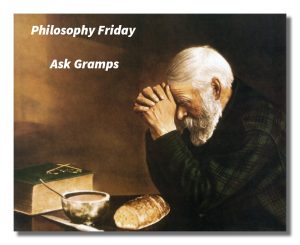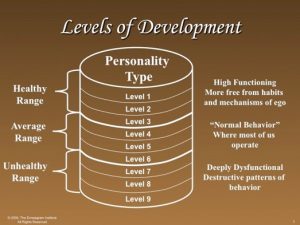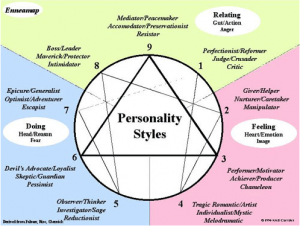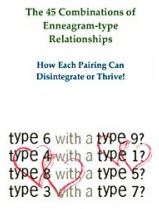
Shownotes
Wisdom-Trek / Creating a Legacy
Welcome to Day 1033 of our Wisdom-Trek, and thank you for joining me.
This is Guthrie Chamberlain, Your Guide to Wisdom
The Enneagram Type Combinations – 3&7; 3&8; 3&9 – Ask Gramps

Wisdom – the final frontier to true knowledge. Welcome to Wisdom-Trek where our mission is to create a legacy of wisdom, to seek out discernment and insights, and to boldly grow where few have chosen to grow before.
Hello, my friend, I am Guthrie Chamberlain, your captain on our journey to increase wisdom and create a living legacy. Thank you for joining us today as we explore wisdom on our 2nd millennium of podcasts. This is Day 1033 of our trek, and it is time for our Philosophy Friday series. Each Friday we ponder some of the basic truths and mysteries of life and how they can impact us in creating our living legacy.
As we continue on this trek called life, sometimes we have questions about life, so our Friday trek is a time when we can “Ask Gramps.” Gramps will answer questions that you would like to ask your dad or granddad, but for whatever reason are unable to. No matter how old we are, I know that all of us would like the opportunity to ask Dad or Gramps questions about life in many areas.
Understanding ourselves and how others may interpret life through their paradigm better allows us to interact with each other with more love and compassion. This can be achieved by utilizing a profound tool called “The Enneagram.” The tool that we refer to as the Enneagram (Any-a-Gram) is a circle with nine interconnected points (Ennea refers to 9 and Gram referring to a drawing). Check out today’s or a prior week’s Wisdom Journal for a representation of it. I have also included a copy of “The Enneagram At-A-Glance,” which was compiled by Suzanne H. Eller in today’s Wisdom Journal. If you would like a PDF copy, click on the link in today’s Wisdom Journal located on our website Wisdom-Trek.com.
For additional insight, I recommend the book The Road Back to You written by Ian Morgan Cron and Suzanne Stabile. It is an excellent book about an enneagram journey to self-discovery from a Christian perspective.
We have concluded our deep dive into the nine types which are “The Reformer,” “The Helper,”“The Achiever,” “The Individualist,” “The Investigator,” “The Loyalist,” “The Enthusiast,” “The Challenger,” and “The Peacemaker.” Seven weeks ago, we began a series of episodes on Type Combinations, answering the question, “What are the potential relationship benefits and issues with each combination?” Covering all of the 45 different potential type combinations will take several weeks, but will be valuable in understanding each other, regardless of what type you are and what type those with whom you interact with each day are.
Since we are exploring the Enneagram in detail, I would also recommend reading the Wisdom Journal for each Friday to see the diagrams presented each week. As helpful as the Enneagram is, keep in mind, it is still only a tool and cannot replace or usurp the precepts that are found in God’s Word. All decisions and actions that we make in life must be in harmony with God’s precepts.
So the questions for the next several weeks will be…
“Hey, Gramps, why do people act and react to situations and circumstances in life so differently? How can I gain wisdom to better understand myself and others so that I can love, serve, and minister to them on a deeper level?”
The Enneagram Type Combinations

The Enneagram Type Combinations
Enneagram Type Three (the Achiever)
with
Enneagram Type Seven (the Enthusiast)
What Each Type Brings to the Relationship
This is a highly complementary pair: both types are self-assertive, have high energy, and are outgoing and capable of being around people with relative ease. Both types bring optimism, a future orientation, the sense of possibility and renewal to their relationships and to enterprises they become involved with. Threes can work alone more easily than Sevens, although both are stimulated by interacting with people and both can be excellent communicators of their ideas and values. Both are persuasive and articulate, often lively and attractive, making them sought-after company. Both have a youthful orientation such that they feed off of each other’s energy: no other couple is as vivacious or gregarious as the Three/Seven couple. This is probably the highest energy combination of types, and they wholeheartedly engage in lots of activities, plans, and projects, with the emphasis on attaining the good life. The focus is on sociability, going out, having adventures together and on realizing possibilities and on finding personal fulfillment.
To this mix, Threes bring sensitivity to people and how to communicate with them, a sense of propriety, appropriateness, and social conventions, as well as the ability to focus on goals and get them accomplished. Sevens bring a sense of fun and adventure, resilience, and not being overly concerned with failure. Sevens can be spontaneous in ways that are helpful to more self-conscious Threes. Sevens bring breadth of knowledge and experience, boundless enthusiasm and good spirits. Threes bring a focus on goals, on staying practical and grounded, and on observing healthy limits. This can be a fun, articulate, generous pair, virtually sparkling with vitality and the joy of life. This can sometimes seem to others to be an almost magical couple.
Potential Trouble Spots or Issues
This is also an extremely volatile couple: there is almost too much electricity under one roof. A Three/Seven pair always looks like a great couple, but this can also mean having to live up to their own hype. They can be exhausting to keep up with, and their mutual qualities make it difficult to admit to or look at problems. They both feel the pressure to be “fabulous” and perfect all of the time. Both types seem light-hearted, and unconcerned; yet, in their high-energy routines, they often hurt each other without realizing it. Often this results in a backlog of past hurts that have been suppressed until it is too late and too much damage has been done.
Depending on their level of health, Threes can become workaholics, completely focused on achieving success, building more prestige, and planning career moves with the care of a general, so much so that relationship and family life takes a distinct second place, if that. By contrast, Sevens tend not to take their career as seriously as Threes, always feeling that if things do not go well in one job they can move to something better. On the surface, Threes seem to have as much self-confidence as Sevens; in reality, they do not, which is why they feel they need to promote themselves and their accomplishments. Threes may be envious of the easy success of Sevens, while Sevens may feel that too much fun and enjoyment is being sacrificed for the Threes’ focus on career. Sevens may get the feeling that they only exist to prop up the Three in various ways. Neither type wants to talk about their shortcomings, failures, or negative feelings, and so these topics tend to be avoided for as long as possible. Often either a health or career crisis will bring things to the surface. Sevens do not want to be trapped in a relationship that is no longer enjoyable, and Threes do not want to be in a relationship that has failed. Once they doubt that the other is there for them, they turn toward self-centered attitudes, which further erode the relationship. A break can come abruptly and be permanent.

Enneagram Type Three (the Achiever)
with
Enneagram Type Eight (the Challenger)
What Each Type Brings to the Relationship
These two types can form powerful and highly effective affiliations and can also have passionate and stimulating personal relationships. Both are assertive: both Threes and Eights go after what they want in life. Both can be larger-than-life figures who are outstanding in some ways and because both stand out in their social circle. They cannot help but notice each other and come to terms with each other. Either an alliance forms that will enhance both parties or a competition develops that will keep them apart. Surprisingly, Eights’ strength and solidity gives Threes permission to be more heartfelt. The Eight feels reliable, and Threes seek safety to reveal their hearts. Eights also like seeing Threes use the opportunities and rise to the challenges they offer. On the other side, it helps Eights to relax once they see that the Three is competent and can do things on their own. Moreover, both Threes and Eights are action-oriented, pragmatic, care about getting the job done and are willing to take the lead to achieve their goals.
They both have a marked degree of self-confidence (at least outwardly), they can be persuasive, and they can cut their losses and change goals when things are not working for them. To this mix, Threes bring more awareness of others and a feeling for public relations and for how to please people. They are more diplomatic and adaptable, both in their relationship with Eights and with others. Eights bring forthrightness in expression, fearlessness, physical vigor, and determination to achieve their personal vision. They bring solidity, decisiveness, and a kind of strength that the more flexible Three gains confidence from. They want to be proud of each other and to support each other’s potentials and accomplishments. They tend not to compete with each other—surprising because both tend, in general, to be competitive with others.
Potential Trouble Spots or Issues
Threes and Eights can be effective in the business world and in their professional careers where energy, determination to succeed, and personal drive are necessary. But both types tend to be workaholics, putting themselves under tremendous stress in order to achieve their goals and to hang onto whatever success they have. Under sufficient stress, they may stop supporting each other and compete to top the other’s achievements. Of the two types, Eights are more openly controlling than Threes, although Threes will attempt to control situations covertly—which can arouse the Eight’s suspicions and lack of trust. Once trust is compromised, Eights can become jealous and possessive, ordering the Three to do things to prove their personal loyalty to the Eight. Threes may easily feel used and belittled, not adequately appreciated for their contributions or for their support of the Eight. Eights begin to expect and demand loyalty—even obedience—for their patronage and guidance. Threes begin to feel that they are losing their ability to pursue their own goals and that they are becoming an appendage of the Eight.
In response to deteriorating conditions, both types can become manipulative to get what they want. Once they begin to do this with each other, trust and openness cannot be maintained. Moreover, neither Threes nor Eights are very skilled at talking about their real feelings or needs, nor do they feel comfortable being vulnerable. For both, isolation and suspicion becomes the norm and can become difficult to break through. Eights may see the Three as deceitful and untrustworthy; Threes may see the Eight as willful and vengeful. And they can fear being humiliated and co-opted for life. Eights ultimately want support for themselves and their vision. Threes want to be developing themselves and to be admired for their qualities. Battles over who is supporting whom result. Whose agenda will prevail? A nasty, very personal, breakup may follow.

Enneagram Type Three (the Achiever)
with
Enneagram Type Nine (the Peacemaker)
What Each Type Brings to the Relationship
This is a fairly common pairing. Nines bring enormous support, encouragement, and a sense of pride in the Threes’ accomplishments. Threes can feel that with the Nine behind them, they are able to be themselves, explore their potential, and become the best mate, friend, or professional that they can be. Threes can help Nines to properly value themselves, to have more self-respect, and to invest in their own development. Nines can help Threes relax and find enjoyment in simple things—Nines give them permission to not drive themselves so much. Both types also want to avoid conflicts and to put a positive spin on things—Nines are genuinely optimistic and look on the bright side, while Threes focus on being positive and hopeful, and are careful to not let people see them being down or depressed. Both types are sociable, idealistic, caring for children, animals, and the underdog. Both are usually hard working and want to achieve a degree of material success that will enable them to take care of others in a kind of extended family where everyone would be safe, comfortable, and thriving. They both want a pleasant, aesthetically pleasing home.
To this mix, Threes bring energy, personal ambition, flexibility, the ability to set and achieve long-term goals, and efficiency. Threes energize Nines and bring change and excitement to the relationship. Nines bring a feeling of safety and steadiness, the assurance that the Three is loved for themselves and not just for their achievements, and the feeling of not being judged or evaluated at every moment. Threes feel that they can let down their hair and really be themselves with Nines who accept them just as they are. The sensuality of the Nine and the attractiveness of the Three can meet in a couple highly attracted to each other and attached by physical passion. In other Three-and-Nine couples, the need for comfort and security may be the main source of attachment and the pleasure they get from each other.
Potential Trouble Spots or Issues
The Three/Nine couple can almost be a case of “too much of a good thing.” Because both types are attracted to keeping the positive values in their lives alive—and there can be so much attachment to comfort and stability in their world—it becomes difficult to question the status quo and the routines that they get into. Neither wants to bring up conflicts that they have with the other. Nines are more likely not to want to talk about whatever is bothering them for fear of further endangering the relationship. But Threes also do not want to express their complaints because doing so will risk rejection and may also expose the fragility or even the falseness of their relationship. Nines feel that it is better not to say anything and to let things work out on their own, if that is at all possible. If Threes are heavily invested in having a “perfect marriage” to the outside world, it will be difficult to talk about their unhappiness in the relationship or the frustrations they are feeling.
Often the relationship will continue for a while as if nothing is wrong even if it is essentially over. Eventually, however, Threes begin to feel unseen and unappreciated and perceive that the Nine is not really there for them—not really present to the relationship. The Nine may be an excellent provider in a material sense, but under stress, may begin to become emotionally absent. Feeling abandoned or rejected usually makes Threes become depressed, although they often do not realize this since they can get quite out of touch with their emotions. Threes can feel that Nines are stifling them, whereas Nines can feel that Threes are too demanding and are “spoiled.” Sometimes a crisis, an affair, or some other major life challenge brings the deterioration of the relationship into awareness. They may go through cycles of breaking up and getting back together, although if the underlying problems are not resolved, the real feelings and frustrations continue and will eventually undermine the relationship.

We will continue each week to look into three additional combinations as we work our way through the numbers. You are important in